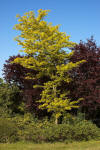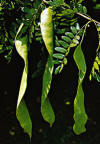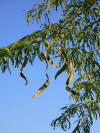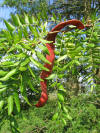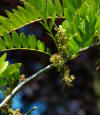WILD
FOODIES' HOME PAGE
PLANT PROFILE LIST
NAME: Honey Locust
SPECIES / FAMILY: Gleditsia Triacanthos / Fabaceae
OTHER COMMON NAME(S): thorny locust
CONDITIONS: full
sun
|
PARTS: |
EDIBLE |
TASTE |
RAW/COOK |
SEASON |
|
All |
|
|
|
|
|
Shoots |
|
|
|
|
|
Leaves |
||||
|
Stalk/Stem |
|
|
|
|
|
Buds |
||||
|
Flowers |
|
|
|
|
|
Fruits |
|
|
|
|
|
Pods |
|
sweet pulp tastes like banana liquor in fall |
COOK
in summer |
Summer > Fall |
|
Seeds |
|
green peas then black beans |
RAW/COOK
in summer, |
Summer > Fall |
|
Nuts |
|
|
|
|
|
Roots |
|
|
|
|
|
Bark |
|
|
|
|
PORTION: small
COMMENT: Related to carob. The Indians used the pulp to make a beverages and for many other uses(4), but I recommend against it for use as a beverage. Read the cautions below. All honey locust trees are not created equal. Some drop big fat pods, that have small seeds, or vice versa. The green pods in the summer have green peas that can be eaten raw or cooked, and taste like peas. The brown seedpod in fall has sweet pulp that smells and tastes like banana liquor and it appears to contain alcohol through natural fermentation and may also contain other toxins. The amount of pulp depends on the tree. Take the brown seed pod, break lengthwise, separating the seed-side from the pulp side. You can also eat the brown pod shell, letting your saliva break it down, as with a carob pod. Pod can also be dried and ground into a powder for cooking or baking. Brown seeds can be roasted and used as a coffee substitute, or soak them for 24 hours, then cook for 1-2 hours, add salt and oil (I prefer walnut oil). Tastes between a baked bean and a soy bean. Again read the cautions.
CAUTION: The plant contains potentially toxic compounds.(1) The juice made from seed pod pulp in the Fall combined with water, although tasty, somewhat like unfiltered apple cider, contains alcohol due to natural fermentation > https://fortheland.org/honey-locust. Sometimes the juice gives me a slight headache or makes me feel light headed.The dark beans seems to have the same effect, but to a much less extent. it might be a good idea that, after boiling the dark brown beans, discard the out layer of the bean. That said, I would treat both the pulp and beans with caution. Frankly, I have to try the beans in the late summer when they are still green, to see if they have the same effect on me. As with any plant, you may be sensitive or allergic to it. // According to PFAF, although it lists the pods and seeds as edible, it also contains potentially toxic compounds.(1) So, proceed with caution. Only use sweet pulp. PFAF reports that green "pod" skin is edible raw or cooked, but this editor disagrees having tried it both ways and found it to be not edible - way too tough, however the brown pod outer shell could be ground to a powder, but I haven't tried that yet.
NUTRITION/MEDICINAL: The oval seeds contain 10.6 - 24.1% protein, 0.8 - 4.3% fat, 84.7% carbohydrate, 21.1% fibre, 4% ash, 280mg calcium and 320mg phosphorus per 100g.(1)
LOOK-A-LIKES / RELATED: Black Locust tree and leaves are similar, although the pods are very small and not edible. The Kentucky Coffee tree's pods are much shorter, but wider and fatter, and need extensive processing.
POISONOUS LOOK-A-LIKES:
OTHER USES: Gum; Soil reclamation; Tannin; Wood. Planted for land reclamation on mining waste. The gum from the seeds has been suggested as an emulsifying substitute for acacia and tragacanth. The heartwood contains 4 - 4.8% tannin. Wood - Largely used for making fence posts and rails, wheel hubs, farm implements etc and in construction.(1)
SOURCE LINKS (may include nutritional and medicinal info, plus other uses):
- https://pfaf.org/user/Plant.aspx?LatinName=Gleditsia+triacanthos
- https://en.wikipedia.org/wiki/Honey_locust
- http://www.foragingtexas.com/2008/08/mesquitehoney-locust.html (good photos)
- https://ethnobotanicalenthusiast.wordpress.com/2017/08/01/honey-locust-gleditsia-triacanthos (good summary of information, although editor is located in England)
- https://gardenerdy.com/honey-locust-tree-facts
- http://permaculture-watch.blogspot.com/2009/08/honey-locust-as-forage-tree.html
- http://southernforager.blogspot.com/2015/10/honey-locust-coffee.html
- https://southernforager.blogspot.com/2015/10/honey-locust-persimmon-beer.html
- https://www.motherearthnews.com/real-food/carob-or-honey-locust-powder-zbcz2008
